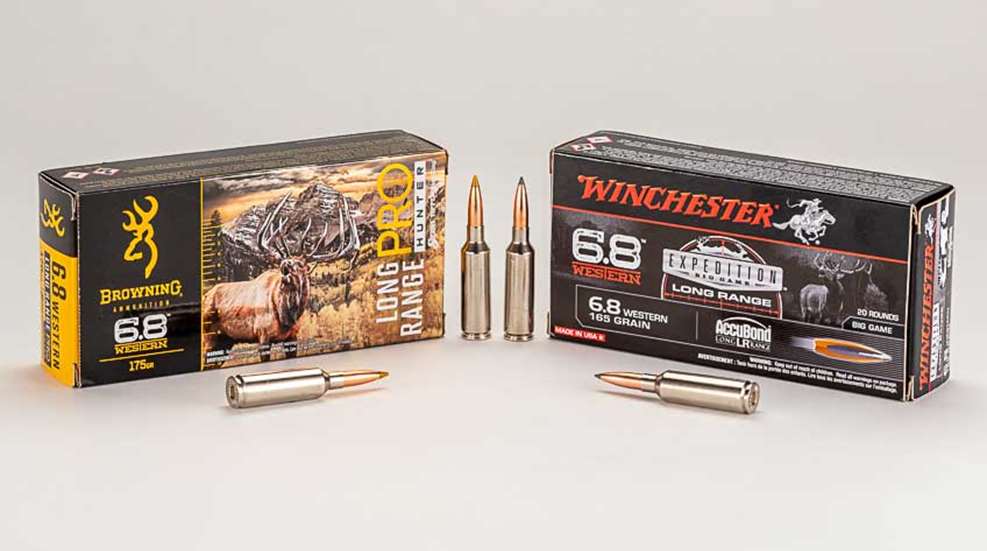
During the 170-plus years since the advent of the self-contained cartridge, dozens of .30-caliber chamberings have been developed. The .22 cal. isn’t far behind, and, given the recent rash of 6.5 mm introductions, the .264-cal. field is getting pretty crowded as well. Yet despite the proven ballistic effectiveness of the diameter’s projectiles—and the extreme popularity of the .270 Winchester in particular—prior to the last year or so, (if we discount an experimental 6.8 mm Chinese Mauser cartridge from the turn of the 20th century that is exceedingly obscure at best and historically dubious at worst) the number of available .277-cal. chamberings had curiously topped out at all of four.
Given the 2020 announcements of SIG Sauer’s .277 Fury and Nosler’s family of energetic magnums growing to include the 27 Nosler, however, one of the loneliest calibers in the cartridge spectrum has become considerably less so of late. Prior to this recent flurry of activity, Winchester Ammunition had long been the king of the .277, having not only launched the bullet diameter itself, but also a full half of the chamberings that utilize it. First came the .270 Win. back in 1925, with the company finally following up in 2001 with a .270 member of the Winchester Short Magnum (WSM) family.
And now that other ammunition manufacturers have begun cuing in on the effective blend of wind-bucking speed, bone-crushing bullet weight and manageable recoil provided by 0.277”-diameter projectiles, Winchester has indicated its unwillingness to cede the ground atop this uniquely American caliber by introducing a new .277 chambering of its own. Making its debut in early 2021, the 6.8 mm Western—offered at launch in a pair of premium hunting loads and with a slate of Browning X-Bolt and Winchester Repeating Arms XPR and Model 70 rifles available chambered to fire them—is Winchester’s attempt to create the ultimate big game/long-range hunting cartridge using the caliber that it first put on the map.
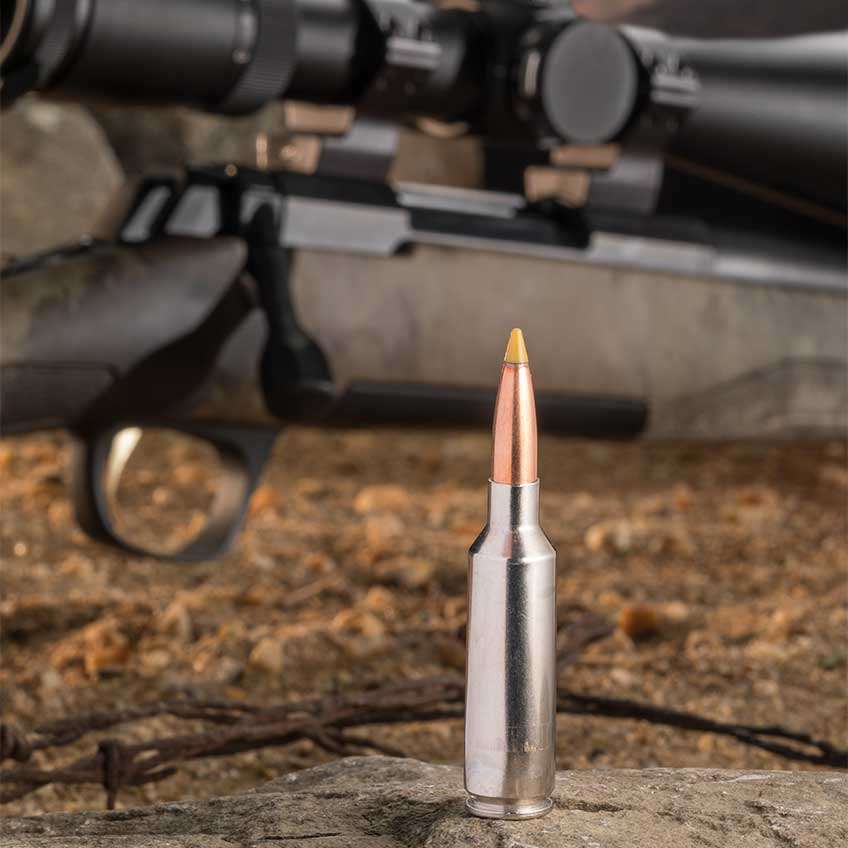
As high of a bar as that may seem to be, after significant time behind the triggers of two different 6.8 mm Western-chambered rifles, including while on an illustrative elk/mule deer hunt in the mountains above Craig, Colo., I have been thoroughly impressed by both the thoughtful simplicity of the design and its consistent effectiveness in the field. An adapted .270 WSM re-designed specifically around the use of projectiles longer and heavier than anything that has existed in the caliber up to this point (while still enjoying the length and weight savings offered by a short action), 6.8 mm Western adds ballistic performance—both externally and terminally—that the .277 cal. has never possessed before.
If anything, the lack of experimentation within the .277 caliber can be, in large part, credited to just how effective hunters have found the .270 Win. to be. Despite 95 years on the market, it is still widely regarded as among the very best options for deer-size game, its high velocities and correspondingly flat trajectories serving to provide hunters with a point-blank range that extends as far as any shot they are likely to encounter—in the eastern United States at least.
But it’s a long, thin cartridge requiring a standard-length rifle action, and, with bullets traditionally spanning from 130 to 150 grs. in weight, some question its suitability for use on larger and tougher animals, particularly as shot distances increase. The .270 WSM effectively addressed the first concern by fitting within short-action receivers, and most loads do offer a bit more velocity and energy at the muzzle compared to .270 Win., but its bullet weights remained unchanged, and Winchester still saw the opportunity to push the .277 caliber’s performance even further.
On The Drawing Board
Long-for-caliber, exposed-ogive projectiles are currently in vogue with cartridge designers, a trend that pays dividends for the hunter both while the bullet is still in the air and once it has impacted its target. This is because a longer (and thereby heavier) bullet not only has an inherently higher ballistic coefficient (BC) than does a shorter, lighter one of the same type in the same caliber, but also a higher sectional density (SD) as well. Previous .277-cal. cartridges (.270 Wby. Mag. and 6.8 mm SPC being the other two) have never really ventured much above 150 grs. in terms of bullet weight, a reality that has always limited the BC and SD figures attainable by the caliber.
Winchester, in joint collaboration with Browning Ammunition, began the 6.8 mm Western project in early 2018 with the goal of improved long-range performance in mind, targeting a G1 BC of no less than 0.600, and company engineers quickly discovered that even the most aerodynamic 150-gr. .277 bullets on the market couldn’t get them there. But by tweaking one key element of the .270 WSM’s design, Winchester found that it had devised a new case capable of accommodating .277-cal. projectiles in the 165- to 175-gr. range—while retaining both the parent’s short-action compatibility and its unbelted design.
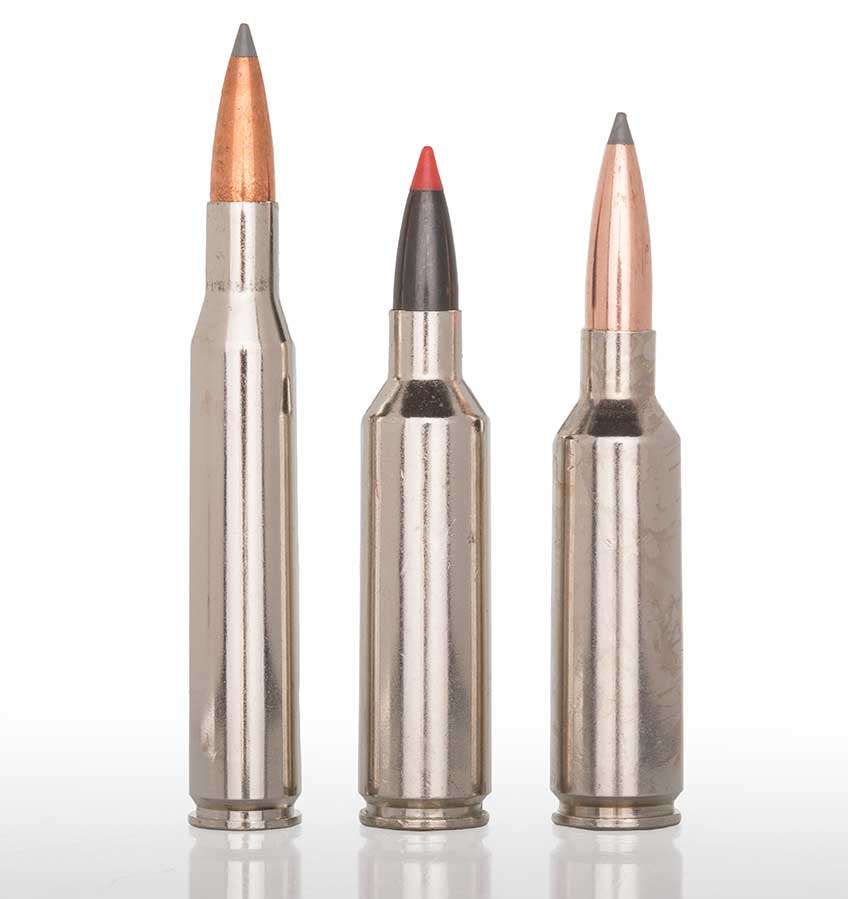
Identical dimensionally in most respects, the .270 WSM and the 6.8 mm Western cartridges both measure 0.535” in diameter at the case head and 0.555” across just forward of the extractor groove, and both have 0.2765”-long necks. They also share the same 35-degree, 0.16”-long shoulder. But by moving that shoulder 0.08” farther back on the new cartridge, and by decreasing its overall case length by the same figure, Winchester was able to create significantly more space for bullet protrusion while keeping the maximum Cartridge Overall Length (C.O.L.) at 2.955”—compact enough to fit within most (if not all) short magnum actions and magazines. This made room for the project’s heavy-for-caliber projectiles without requiring them to extend too deeply into the case.
Bumping the shoulder down and shortening the case length does result in the new cartridge having a somewhat lower case capacity than its predecessor—74.0 grs. for 6.8 mm Western compared to 78.6 grs. for .270 WSM. But the higher bullet weights used by the newcomer offset this slight loss of velocity from a kinetic energy standpoint—while operating at the same 65,000 p.s.i. Maximum Average Pressure. Of course, stabilizing the 6.8 mm Western’s longer bullets does necessitate the use of a rifling twist rate faster than the .277’s traditional 1:10”, and Winchester discovered that increasing the rifling to 1:8” did the trick.
Once the case and chamber dimensions were finalized, Winchester Ammunition reached out to Nosler and Sierra with the cartridge concept and the necessary projectile benchmarks, collaborating with the companies to produce the bullets utilized by the 6.8 mm Western’s two launch offerings. The two initial ammunition options are a Winchester Expedition Big Game Long Range (EBGLR) load topped with a 165-gr. Nosler AccuBond Long Range (ABLR) bullet, and a Browning Long Range Pro Hunter (LRPH) ammunition topped with a 175-gr. Sierra Tipped GameKing (TGK). Incidentally, Nosler was already working on a heavy-weight .277 projectile itself, and would go on to utilize the fruits of this partnership, the 165-gr. ABLR used in Winchester’s EBGLRs, atop its 27 Nosler Trophy Grade Long-Range (TGLR) ammunition.
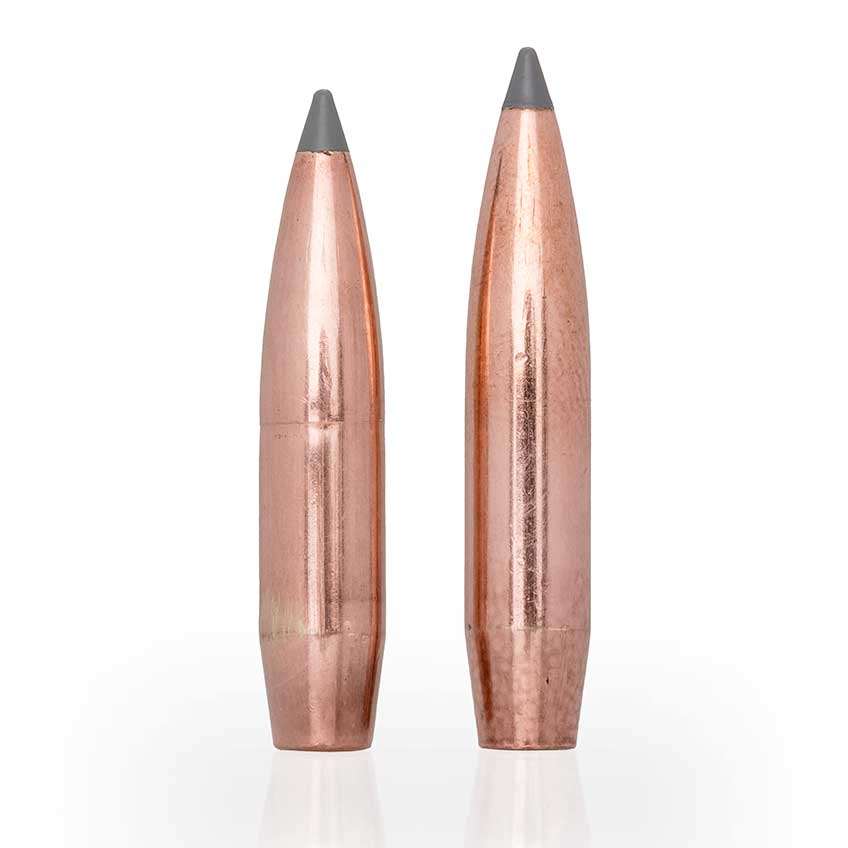
Similar in application but not identical in terms of intended behavior within the animal—the bonded Nosler projectile was designed to favor penetration, while the non-bonded Sierra errs more on the side of a speedier energy dump—both loads are nonetheless appropriate for all North American big game and African plains game. Also already coming down Winchester’s pike, but each at various different stages of development and none ready in time to be included in this article’s testing, are: a 170-gr. Ballistic Silvertip load geared more toward deer and antelope hunting; a 170-gr. open-tip match offering that will be among the first .277-cal. projectiles of this type; and a Deer Season XP Copper Impact for use in lead-free states, the weight of which hasn’t yet been finalized.
Prior to recent times, an American ammunition maker choosing “6.8 mm Western” for the designation of its new cartridge would have been an odd choice for two reasons. One, because when naming their new creations big manufacturers have previously tended to include the company name in some fashion as a subtle form of built-in embedded marketing, and, two, because for a long time in America there was a mild stigma attached to metric cartridges. But the past decade or so has seen many companies seemingly move beyond these conventions—with the modern dominance of 9 mm Luger and 6.5 mm Creedmoor no doubt helping to put such constraints to rest.
In the case of this cartridge, however, I think the “Western” moniker works on a couple of different levels. Primarily because it connotes the type of far-reaching, cross-canyon shots that hunting in the wide-open spaces of America’s higher longitudes often requires—the exact types of shots at which this magnum excels. But it’s likewise appropriate because, for many, the Winchester name is still fondly synonymous with the 19th century taming of the western frontier—not to mention that it also harkens back to the days of the old Western Cartridge Co., which was founded by Olin Corp. (Winchester Ammunition’s parent company) in 1898.
And, of course, given that the company’s two existing .277-cal. chamberings already make use of the “.270” prefix, I think the decision to go metric with this one was a smart move from a differentiation standpoint if nothing else. The finished cartridge was presented to SAAMI at its January 2020 meeting—with approval coming in September of last year.
The Tale Of The Tape
In order to get a better sense of the ballistic superiority of the 6.8 mm Western’s longer projectiles relative to those used by existing .277-cal. chamberings, as well as to gauge the overall capabilities of the new cartridge itself, head-to-head comparisons with loads making use of the same bullet types can be beneficial. And of the loads available to the market at the time of writing, pitting Winchester’s 165-gr. 6.8 mm Western EBGLR ammunition against the company’s .270 Win. 150-gr. version from the same line and Nosler’s .270 WSM 150-gr. TGLR load provides us with the most direct comparisons possible—as all three employ 0.277” AccuBond Long Range projectiles. Pulling the bullets from each cartridge revealed the 165-gr. 6.8 mm Western ABLR to be just a bit shy of one tenth of an inch longer (1.520”) than the 150-grainers (1.425”).

According to each company’s provided tables, the 6.8 mm load runs 2970 f.p.s. at the muzzle through a 24” test barrel, generating 3,231 ft.-lbs. of energy, while the .270 Win. and .270 WSM loads travel 2900 f.p.s. and 2960 f.p.s., (2,801 ft.-lbs. and 2,918 ft.-lbs.), respectively, through test barrels of identical length. Due to having the same width but a longer length, the 165-gr. bullet boasts an extraordinary G1 BC of 0.620, considerably higher than the 0.591 offered by the 150-gr. AccuBond—which is itself an excellent ballistic coefficient for the .277 cal. With less drag acting on the larger bullet, it still retains 2,605 ft.-lbs. of energy at 200 yds. and 1,856 ft.-lbs. at 500, compared to 2,262 ft.-lbs. and 1,611 ft.-lbs. for the .270 Win., and 2,327 ft.-lbs. and 1,619 ft.-lbs. for the .270 WSM at those same distances. Meanwhile on the velocity side of the equation, the 6.8 mm Western ABLR stays supersonic for approximately 1,600 yds. and remains above the transonic range out well beyond 1,000 yds.
Much of the esteem for which .270 Win. is still held today is due to its shot-simplifying flat trajectories and its ability to resist being turned off course by the wind, and rightfully so. But in our comparison here, we’ll see that the 6.8 mm Western actually gets the nod in both of these regards by a slim margin as well. With all three zeroed at 200 yds., despite weighing 10 percent more, the 165-grainer edges out both .270s, dropping only 6.3” at 300, 18.1” at 400 and 36” at 500 yds. Compare that to the drops of the .270 Win. (6.8”, 19.3” and 38.5”) and .270 WSM loads (6.4”, 18.4” and 36.7”) at the same three spots.
Likewise, in terms of wind deflection, the 6.8 mm Western is knocked only 13.2” off its path at 500 yds. by a 10-m.p.h., full-value crosswind—while the .270 Win. and .270 WSM deflect 14.5” and 14”, respectively, from the same 90-degree winds. And while it should be noted that, depending on the designs of their tips, some 130-gr. .277-cal. loads will be able to buck gravity and the wind better than can the currently available 6.8 mm Western loads due to their higher velocities, they do so at a major bullet weight penalty.
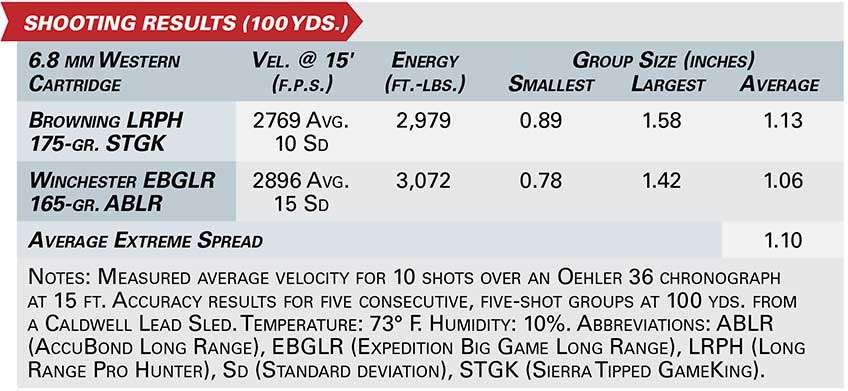
This brings our head-to-head comparison of the 150- and 165-gr. ABLRs to the sectional density metric, which is essentially the measure of a projectile’s ability to continue penetrating through a target after impacting it. To provide a frame of reference, anything above 0.300 is considered to be an outstanding penetrator. The 150-gr. bullet used by both .270s has a very respectable SD of 0.279; the 165-gr. ABLR’s SD is 0.307. This difference is substantial, and when you’re stepping up your game from 250-lb. deer to 700-lb. elk, every bit of additional terminal ballistic advantage is worthwhile.
Lastly, because it exploits significantly heavier bullet weights (we are far more accustomed to seeing projectiles in this weight range used by .30-cal. cartridges) the 6.8 mm Western punches like it’s in a heavier weight class than its fellow .277 brethren. While it can be difficult to quantify a given cartridge’s lethality, especially relative to another cartridge’s—as you can’t shoot the same animal with both—I find that nothing comes close to matching the insights provided by hands-on, empirical data of actual animals downed. And thanks to a late-October trip to the northwest corner of Colorado in the company of Ivory Tip Outfitters and five other hunters, I have seen plenty of first-hand evidence of just how effective 6.8 mm Western can be.
In The Field And At The Range
The majestic elk has always occupied a prominent spot on my hunting bucket list—partly because of its immense size and grand stature, and partly because wapiti are easily the best-eating venison that I have yet to encounter. So, when, after more than five years on the job, the first opportunity to pursue an elk came my way, I snatched it up. I was so excited that I even went about losing close to 40 lbs. to help ensure that my sometimes-suspect back would be able to handle the strain of a four-day expedition up and down the Rocky Mountains.
Without an accurate rifle and reliable glass, however, even the best cartridge amounts to nothing more than wasted potential, and fortunately, the equipment I traveled west with performed to a tee. All six hunters were kitted out with 24”-barreled Winchester XPRs, each magazine filled with the 165-gr. Winchester 6.8 mm Western load. A superb choice for this trip, both due to its ideal magnification range for western hunting and its first-rate glass, atop the rifles were 3-18X 44 mm Leupold VX-6HD riflescopes outfitted with the maker’s idiot-proof Custom Dial System elevation turret. Tuned specifically to our ammunition of choice, with the come-ups already calculated by Leupold, CDS allowed us to simply zero the XPRs at 100 yds. and then just dial to the target’s actual distance for a dead-on shooting solution.
During the course of our hunt, the six of us accounted for a total of 11 harvested animals (five elk, five mule deer and one pronghorn). Shots ranged from 75 to 475 yds., with the average for all 11 beasts coming in at 280 yds. Incredibly, five of the 11 were dead right there, without taking a step (including the 475-yd. poke that anchored a trophy bull elk), no animal required more than two shots and none ventured more than 30 yds. post-impact before expiring. These are some pretty magnificent results given the distances involved. Shots were taken both through the shoulder and farther back into the lungs, and all but three bullets completely passed through and exited their animals.
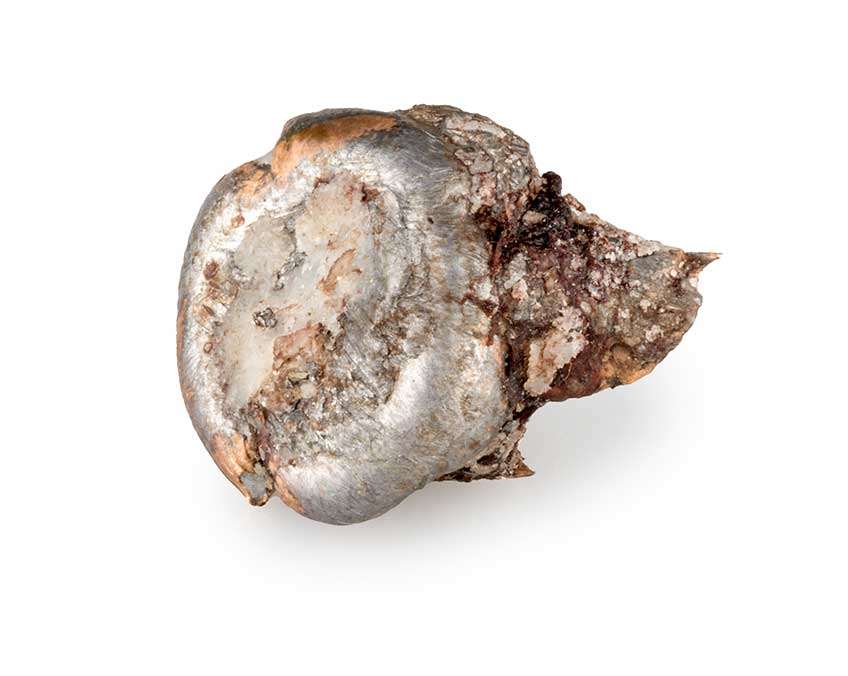
I myself was blessed enough to connect on both a mule deer and an elk during the trip. Not yet rendered completely stupid by the rut, but apparently too hungry to be concerned by my presence, the sturdy, nine-point muley buck was taken on the morning of the second day with a 75-yd. chip shot to the torso that penetrated fully and obliterated both lungs on its way through. He slowly staggered forward maybe 10 yds. after the hit before dropping.
On the other hand, I found myself within the final hour of light on the final day of the hunt without yet having been able to scratch that elk off my list. Accepting that a bull wasn’t in the cards, when I came upon a group of about a dozen cows I knew it was now or never. And when they then caught scent of us and decided not to stick around, I took the only shot available to me—a snap shot from 220 yds. at the lone one in the pod not clustered tightly against the others.
A solid hit, the cow crumpled where she stood; upon inspection of the body, the 6.8 mm bullet had shattered both of her shoulders and then lodged itself under the hide on the far side, and could be felt rolling around just under the skin. The excised projectile had expanded to between 0.51” and 0.60” in diameter, and still retained 77.8 grs. of its initial 165-gr. weight—decent performance given how much bone it had impacted.
Upon returning from Colorado, I coordinated with Browning to have one of its 6.8 mm Western-chambered X-Bolts sent in for formal evaluation (Browning is using a faster 1:7.5” rifling twist rate); the specific model I received was the 24”-barreled Western Hunter, with an A-TACS Arid Urban-camouflaged synthetic stock and an adjustable comb riser. Using Rifleman’s established five-shot, five-group accuracy standard, the 6.8 mm Western excelled through the Browning at the range, just as it had through the XPR in the field. The 165-gr. ABLRs won out by a small margin, managing a five-group mean of 1.06” at 100 yds., with the heavier Long Range Pro Hunter load still posting an excellent 1.13” average. Even the worst group of the day (1.58”) would have served a hunter well out to any responsible hunting distance.
While unquestionably a magnum, even chambered in light, 7-lb. rifles such as Winchester’s XPR and Browning’s X-Bolt, the 6.8 mm Western was surprisingly pleasant to shoot. Recoil was notably less than 7 mm Rem. Mag. and .300 Win. Mag. rifles of similar weight that I’ve fired, and was just a mite more than what I’ve come to expect from the .30-’06 Sprg. In the field, cushioned by four layers of winter clothing, recoil was not consequential enough to hinder an accurate shot on game.
New cartridges truly do face an uphill battle upon release. Not only must they compete against the innumerable chambering options already available, but I can think of no other facet of the gun world that is subjected to even a fraction of the wary scrutiny and blind derision that a cartridge introduction is—and I’m certainly not immune to this myself. “This thing doesn’t do anything my ____ can’t do,” is such a near-constant refrain within hunting circles, even in circumstances where it is patently false, that it might as well be our motto.
But after seeing nearly a dozen large beasts fall to the cartridge in impressive fashion, and then coming home and crunching the numbers, I’m sold on the concept of the long and heavy .277 on shots where longer distances and whipping winds may come into play. For years now, I’ve toyed around with the notion of either building or purchasing a dedicated elk rifle, the hang-up always being deciding on the chambering. After my experience with 6.8 mm Western, that dilemma has been resolved and the project has begun anew.
Within these pages, Craig Boddington once opined that the .270 Winchester cartridge “will accomplish any reasonable task it is asked to perform at any reasonable range.” With the increased ballistic potential of the 6.8 mm Western, Winchester Ammunition has now broadened the boundaries of what can be considered reasonable.

































